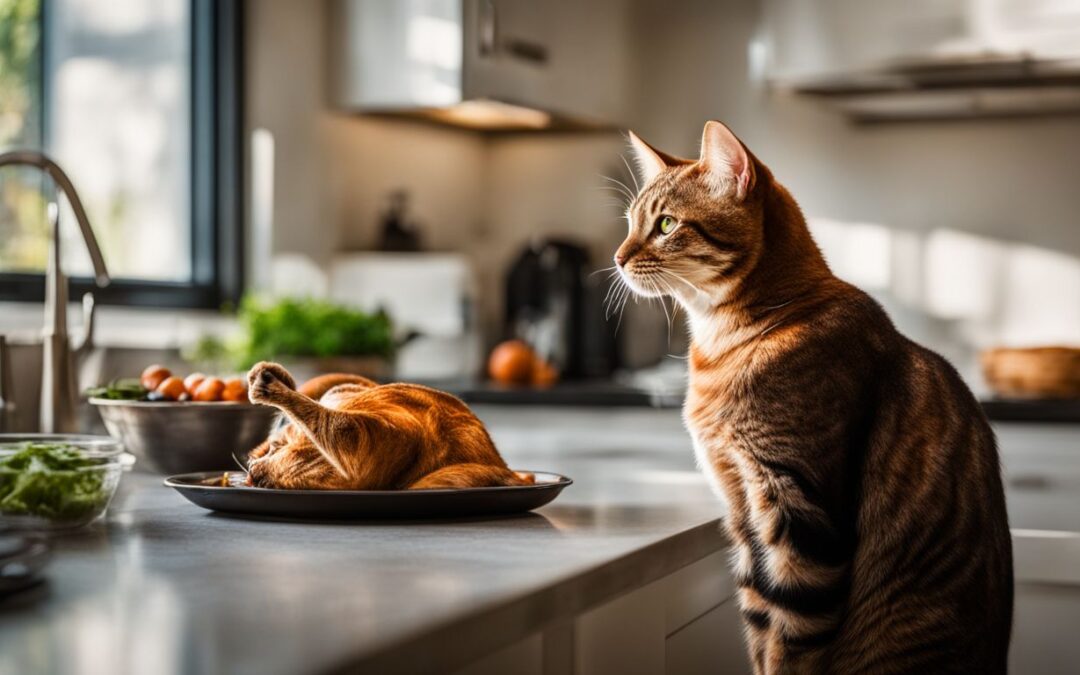As a cat owner, I often catch myself in the kitchen, looking down at those big, hopeful eyes and wondering if it’s okay to share a bit of my dinner—especially when it’s something as tempting as rotisserie chicken.
It turns out I’m not alone in this dilemma. After diving into some research, I discovered that while our feline friends can indeed enjoy cooked chicken, there are several important factors to consider for their health and safety.
From the nutritional benefits to how you should properly offer rotisserie chicken to your cat, here’s what I found. Stay tuned!
Key Takeaways
- Cats can enjoy rotisserie chicken as a healthy treat if it’s plain and without bones.
- Never give your cat chicken with spices or seasoning, since some ingredients like garlic and onion are toxic to them.
- Always remove the skin and bones from the chicken before giving it to your cat to prevent choking or digestive problems.
- Rotisserie chicken should only be an occasional treat for cats, not a regular part of their diet. Limit it to once or twice a week at most.
- Besides rotisserie chicken, cooked eggs, fish, lean meats, certain vegetables, plain yogurt, and small amounts of fruit can also be good food options for cats.
Can Cats Eat Rotisserie Chicken?
Yes, cats can eat rotisserie chicken as a healthy option. However, it is important to ensure that the chicken is unseasoned and boneless to avoid potential risks.
Nutritional benefits
Rotisserie chicken can be a healthy option for cats as it’s packed with proteins, which are essential nutrients in their carnivore diet. Cats thrive on meat, and poultry like chicken offers them the high-quality protein they need to maintain lean muscle mass.
It also provides them with vital vitamins and amino acids that support overall health, from skin and coat condition to digestive health.
Safety concerns
Feeding cats rotisserie chicken involves some safety concerns. It’s essential to avoid feeding seasoned or spiced chicken, as these may contain ingredients that are harmful to cats.
Also, ensure the chicken is thoroughly cooked and free from any bones before offering it to your pet.
Another safety consideration is potential allergies or intolerances. As with any new food, monitor your cat for any adverse reactions after introducing rotisserie chicken into their diet.
If you notice any digestive upset or allergic symptoms, consult a vetapproved professional immediately to ensure your feline friend’s well-being.
How to Safely Feed Rotisserie Chicken to Your Cat
When feeding rotisserie chicken to your cat, ensure it is plain and boneless. Be mindful of portion sizes and limit it to occasional treats.
Preparing rotisserie chicken for your cat
When preparing rotisserie chicken for your cat, it’s important to follow these steps:
- Remove the skin and bones from the chicken to prevent choking hazards and gastrointestinal issues.
- Shred or chop the meat into small, bite-sized pieces that are easy for your cat to eat.
- Ensure the chicken is plain and free from any seasoning, as certain spices like garlic and onion can be toxic to cats.
- Cooked chicken should be fresh and not spoiled to avoid foodborne illnesses in your feline companion.
- Introduce rotisserie chicken gradually into your cat’s diet to monitor for any adverse reactions or digestive upsets.
Remember, it’s always best to consult with your veterinarian before making changes to your cat’s diet.
Portion control and frequency
Portion control is essential when feeding rotisserie chicken to cats. It’s crucial to give them small pieces, ensuring that they don’t consume too much at once. Additionally, it’s important not to make rotisserie chicken a regular part of their diet.
Instead, feed it as an occasional treat, no more than once or twice a week. This approach helps maintain a balanced feline diet while minimizing the risk of any potential digestive issues.
Moving on from portion control and frequency, let’s discuss alternatives to rotisserie chicken for cats.
Alternatives to Rotisserie Chicken for Cats
Consider other human foods or commercial cat food options as alternatives for your feline friend.
Other human foods
When considering other human foods for cats, it’s important to introduce variety and balance into their diet. Here are some safe and nutritious options:
- Cooked Eggs: A good source of protein and amino acids.
- Cooked Fish: High in omega-3 fatty acids, beneficial for heart and kidney health.
- Lean Meat: Such as beef or turkey, can provide essential nutrients.
- Cooked Vegetables: Carrots, peas, or green beans offer fiber and vitamins.
- Plain Yogurt: Probiotics promote gut health when given in moderation.
- Fresh Fruit: Small amounts of fruits like blueberries or apples can be a tasty treat.
By including these foods in your cat’s diet, you can offer a well-rounded nutritional experience that keeps them healthy and satisfied.
Commercial cat food options
When considering commercial cat food options, it’s essential to prioritize balanced nutrition tailored to feline dietary needs. Look for products labeled as complete and balanced, ensuring they meet AAFCO (Association of American Feed Control Officials) standards.
Brands offering grain-free or limited ingredient formulas can be suitable for cats with intolerances. It is advisable to opt for high-quality options that prioritize animal-sourced proteins like chicken, turkey, or fish without artificial additives or fillers.
Additionally, incorporating wet food into your cat’s diet can contribute to their overall hydration and offer variety in texture and flavor.
By prioritizing reputable brands and scrutinizing ingredient labels, pet parents can navigate the ever-evolving world of cat nutrition while seeking more than just sustenance but also optimal health for their furry companions.
Making informed choices when it comes to commercial cat food ensures a robust foundation for feline well-being.
Conclusion: Ensuring a Balanced Feline Diet
After understanding the nutritional benefits and safety concerns, it’s clear that cats can eat rotisserie chicken. Safely feeding them involves preparing it without seasoning and controlling portions.
While chicken is fine as an occasional treat, it shouldn’t replace their balanced diet of commercial cat food and other suitable human foods. Always keeping in mind my feline friend’s dietary needs ensures a happy and healthy pet.
FAQs
1. Can I give my cat rotisserie chicken?
Yes, I can feed my cat rotisserie chicken, but I need to make sure it’s plain and without any seasoning. Seasoned chicken might have spices that are not safe for cats.
2. Is chicken a good food choice for my cat’s diet?
Chicken can be a part of healthy pet nutrition when given correctly. It should meet the dietary needs of my cat and be free from harmful seasonings or sauces.
3. What risks come with feeding my cat seasoned rotisserie chicken?
Feeding cats seasoned rotisserie chicken poses risks because some seasonings are toxic to them. It’s safer to stick with plain, cooked chicken without any added flavors.
4. How do I safely include human foods like chicken in my cat’s diet?
When including safe human foods like plain cooked chicken in my cat’s diet, I always ensure it is properly prepared—boneless and fully cooked—to prevent choking or digestive issues.






